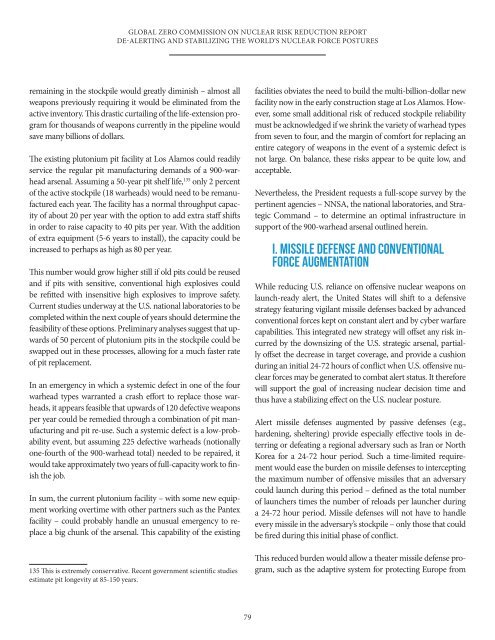global_zero_commission_on_nuclear_risk_reduction_report
global_zero_commission_on_nuclear_risk_reduction_report
global_zero_commission_on_nuclear_risk_reduction_report
You also want an ePaper? Increase the reach of your titles
YUMPU automatically turns print PDFs into web optimized ePapers that Google loves.
GLOBAL ZERO COMMISSION ON NUCLEAR RISK REDUCTION REPORTDE-ALERTING AND STABILIZING THE WORLD’S NUCLEAR FORCE POSTURESremaining in the stockpile would greatly diminish – almost allweap<strong>on</strong>s previously requiring it would be eliminated from theactive inventory. This drastic curtailing of the life-extensi<strong>on</strong> programfor thousands of weap<strong>on</strong>s currently in the pipeline wouldsave many billi<strong>on</strong>s of dollars.The existing plut<strong>on</strong>ium pit facility at Los Alamos could readilyservice the regular pit manufacturing demands of a 900-warheadarsenal. Assuming a 50-year pit shelf life, 135 <strong>on</strong>ly 2 percentof the active stockpile (18 warheads) would need to be remanufacturedeach year. The facility has a normal throughput capacityof about 20 per year with the opti<strong>on</strong> to add extra staff shiftsin order to raise capacity to 40 pits per year. With the additi<strong>on</strong>of extra equipment (5-6 years to install), the capacity could beincreased to perhaps as high as 80 per year.This number would grow higher still if old pits could be reusedand if pits with sensitive, c<strong>on</strong>venti<strong>on</strong>al high explosives couldbe refitted with insensitive high explosives to improve safety.Current studies underway at the U.S. nati<strong>on</strong>al laboratories to becompleted within the next couple of years should determine thefeasibility of these opti<strong>on</strong>s. Preliminary analyses suggest that upwardsof 50 percent of plut<strong>on</strong>ium pits in the stockpile could beswapped out in these processes, allowing for a much faster rateof pit replacement.In an emergency in which a systemic defect in <strong>on</strong>e of the fourwarhead types warranted a crash effort to replace those warheads,it appears feasible that upwards of 120 defective weap<strong>on</strong>sper year could be remedied through a combinati<strong>on</strong> of pit manufacturingand pit re-use. Such a systemic defect is a low-probabilityevent, but assuming 225 defective warheads (noti<strong>on</strong>ally<strong>on</strong>e-fourth of the 900-warhead total) needed to be repaired, itwould take approximately two years of full-capacity work to finishthe job.In sum, the current plut<strong>on</strong>ium facility – with some new equipmentworking overtime with other partners such as the Pantexfacility – could probably handle an unusual emergency to replacea big chunk of the arsenal. This capability of the existing135 This is extremely c<strong>on</strong>servative. Recent government scientific studiesestimate pit l<strong>on</strong>gevity at 85-150 years.facilities obviates the need to build the multi-billi<strong>on</strong>-dollar newfacility now in the early c<strong>on</strong>structi<strong>on</strong> stage at Los Alamos. However,some small additi<strong>on</strong>al <strong>risk</strong> of reduced stockpile reliabilitymust be acknowledged if we shrink the variety of warhead typesfrom seven to four, and the margin of comfort for replacing anentire category of weap<strong>on</strong>s in the event of a systemic defect isnot large. On balance, these <strong>risk</strong>s appear to be quite low, andacceptable.Nevertheless, the President requests a full-scope survey by thepertinent agencies – NNSA, the nati<strong>on</strong>al laboratories, and StrategicCommand – to determine an optimal infrastructure insupport of the 900-warhead arsenal outlined herein.I. MISSILE DEFENSE AND CONVENTIONALFORCE AUGMENTATIONWhile reducing U.S. reliance <strong>on</strong> offensive <strong>nuclear</strong> weap<strong>on</strong>s <strong>on</strong>launch-ready alert, the United States will shift to a defensivestrategy featuring vigilant missile defenses backed by advancedc<strong>on</strong>venti<strong>on</strong>al forces kept <strong>on</strong> c<strong>on</strong>stant alert and by cyber warfarecapabilities. This integrated new strategy will offset any <strong>risk</strong> incurredby the downsizing of the U.S. strategic arsenal, partiallyoffset the decrease in target coverage, and provide a cushi<strong>on</strong>during an initial 24-72 hours of c<strong>on</strong>flict when U.S. offensive <strong>nuclear</strong>forces may be generated to combat alert status. It thereforewill support the goal of increasing <strong>nuclear</strong> decisi<strong>on</strong> time andthus have a stabilizing effect <strong>on</strong> the U.S. <strong>nuclear</strong> posture.Alert missile defenses augmented by passive defenses (e.g.,hardening, sheltering) provide especially effective tools in deterringor defeating a regi<strong>on</strong>al adversary such as Iran or NorthKorea for a 24-72 hour period. Such a time-limited requirementwould ease the burden <strong>on</strong> missile defenses to interceptingthe maximum number of offensive missiles that an adversarycould launch during this period – defined as the total numberof launchers times the number of reloads per launcher duringa 24-72 hour period. Missile defenses will not have to handleevery missile in the adversary’s stockpile – <strong>on</strong>ly those that couldbe fired during this initial phase of c<strong>on</strong>flict.This reduced burden would allow a theater missile defense program,such as the adaptive system for protecting Europe from79


